| THE
ING NEWSLETTER |
No.
5, October 2001 |
Other
available formats: PDF
| The
Planetary Nebula Spectrograph Successfully Commissioned |
 |
M. R.
Merrifield (University of Nottingham), N. G. Douglas (Kapteyn Institute),
K. Kuijken (Kapteyn Institute) and A. J. Romanowsky (Kapteyn Institute),
for the PN.S Consortium
The
Planetary Nebula Spectrograph (PN.S) was successfully commissioned on the
William Herschel Telescope on the night of 2001 July 16. This instrument
was designed and built by an international consortium with members in Australia,
The Netherlands, Italy, the UK, ESO and the USA (a full list of contributors
can be found at http://www.astro.rug.nl
/~pns/pns_team.html). The PN.S is specifically designed to detect large
numbers of planetary nebulae (PNe) in external galaxies and measure their
line-of-sight velocities in a single exposure. In essence, it comprises
twin slitless wide-field spectrographs behind a narrow band 5007Å
filter. These spectrographs disperse light in opposite directions, so that
images of PNe, which emit most of their light in the 5007Å [OIII]
emission line, are shifted in opposite directions in the two arms of the
spectrograph by amounts proportional to their Doppler shifts. Thus, by
matching up pairs of PN images in the two arms, it is possible simultaneously
to determine the locations of PNe, measure their brightnesses, and determine
their line-of-sight velocities. A more complete description of the instrument,
the technique, and its application to studying galaxy dynamics, can be
found in ING Newsletter, 4,
23.
The commissioning team,
led by Nigel Douglas (Kapteyn Institute), mounted the PN.S at the Cassegrain
focus of the WHT (see Figure 1) over the weekend
of 2001 July 14–15. Integrating the instrument with the telescope and ING
CCDs went very smoothly. Focussing and wavelength calibration proved straightforward
using the telescope's calibration lamps to illuminate a grid of holes in
a moveable mask inside the spectrograph. The Observatory Open Day on July
15 gave plenty of opportunity for quantifying the negligible flexure in
the PN.S as the telescope was slewed around the sky for the visitors (and
the commissioning team made an interesting extra "exhibit" on the tour
! ). On the commissioning night of 2001 July 16, the instrument was put
through its paces on the sky. Photometric conditions allowed confirmation
that the instrument meets its designed 30% sky-to-detector efficiency –this
high throughput is made possible by the custom design of the instrument
to observe the single 5007Å line. Unfortunately, exceptionally poor
seeing (more than five arcseconds at times ! ) meant that the full potential
of the PN.S to detect faint point-source PNe could not be fully tested.
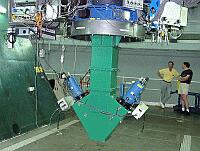 |
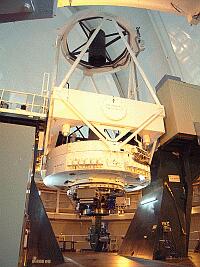 |
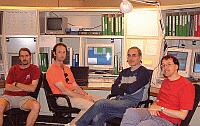 |
| Figure 1. Top left: The
Planetary Nebula Spectrograph fully assembled and integrated with the WHT,
and EEV CCDs and controllers mounted on each arm of the spectrograph. [
JPEG | TIFF ] Bottom
left: First light commissioning team. [ JPEG
| TIFF ] Right: General view of the PN.S and
the WHT. [ JPEG | TIFF
] |
Poor seeing, broken cloud
and dust on the following three nights of the science run (jointly awarded
by the UK and Netherlands TACs) restricted the range of science that could
be attempted, but some data was obtained for nearby galaxies and Galactic
calibration sources. An example of the raw data from the two arms of the
spectrograph, and the ease with which they can be combined to detect PNe
and their kinematics, is shown in Figure 2.
In September, a six night
observing run coincided with some rather better weather, and excellent
observations were made of a number of flattened early-type galaxies. Figure
3 shows the kinematics that were derived from a preliminary analysis
of an observation of the S0 galaxy NGC7457. With data of this quality,
the study of stellar dynamics in early-type galaxies is set to be revolutionized.
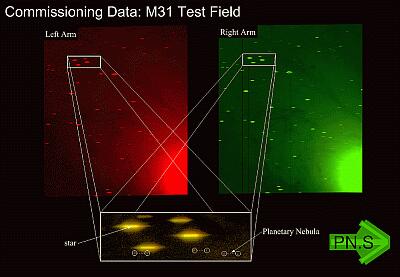 |
| Figure 2. One of the observed fields
in M31, showing the data recorded by the two arms of the spectrograph,
colour coded in red and green. The inset combined image shows how stellar
spectra appear as superposed continua, limited in length by the response
of the narrow-band filter, whereas planetary nebulae show up as point sources,
offset between the two arms by an amount depending on each nebula's Doppler
shift. [ JPEG | TIFF
] |
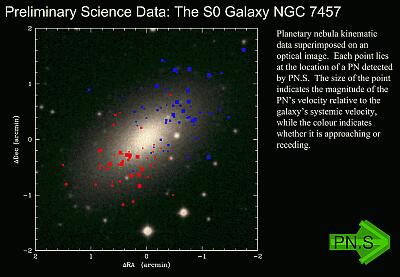 |
| Figure 3. Preliminary analysis
of a PN.S observation of the S0 galaxy NGC 7457. [ JPEG
| TIFF ] |
Email
contact: Michael Merrifield (michael.merrifield@nottingham.ac.uk)
© Isaac Newton
Group of Telescopes, La Palma, 2001.





